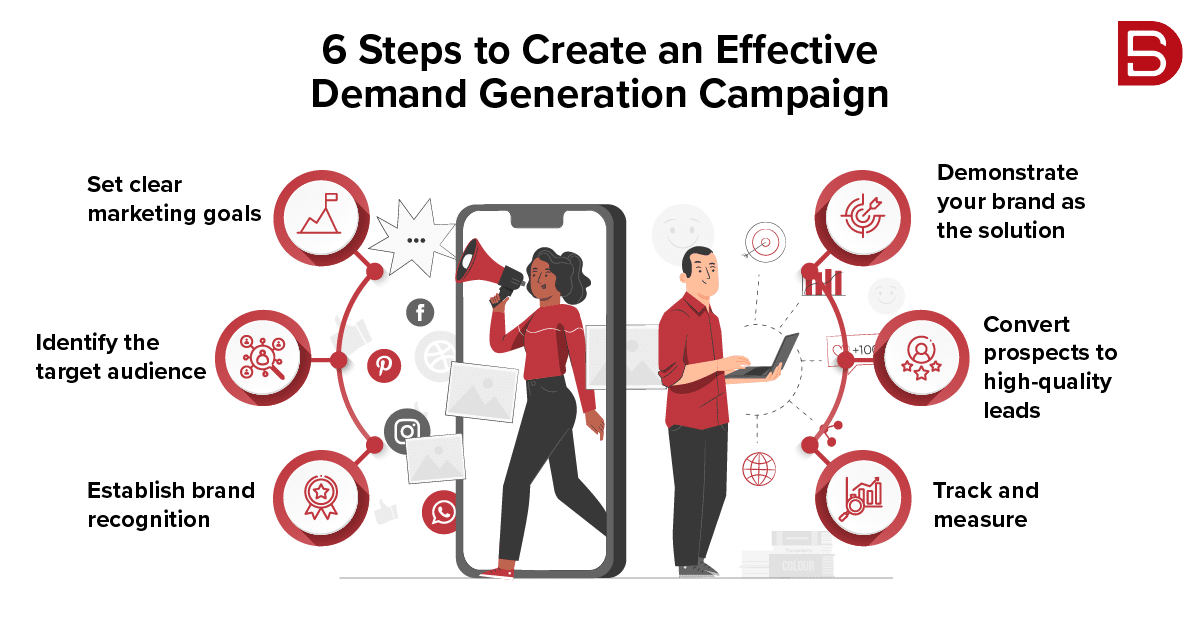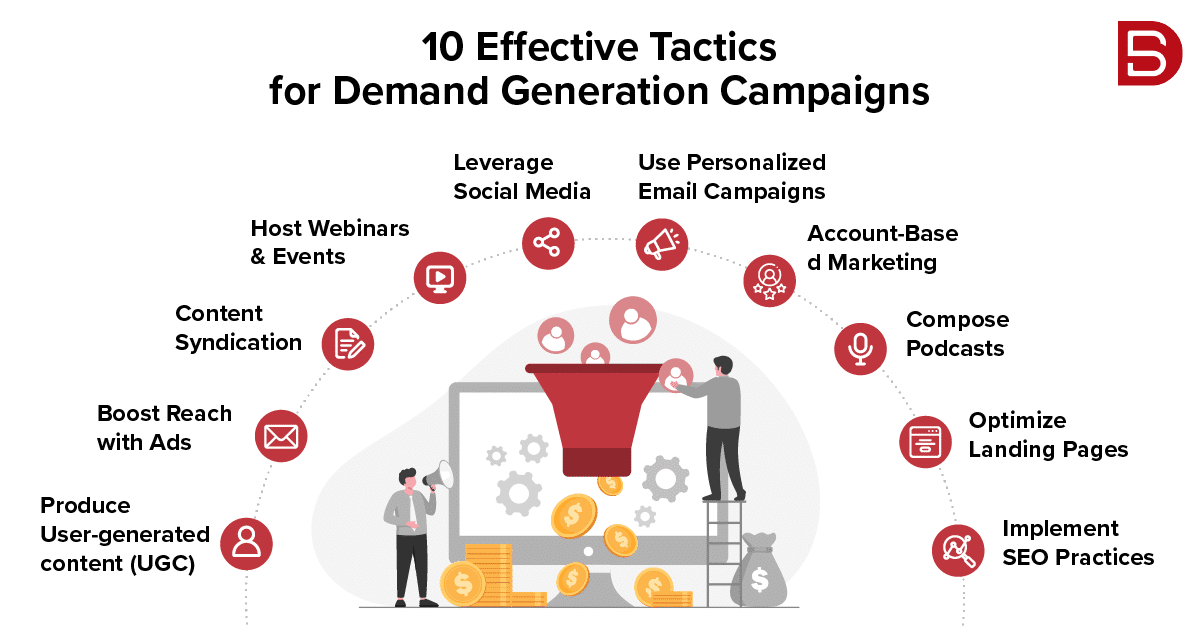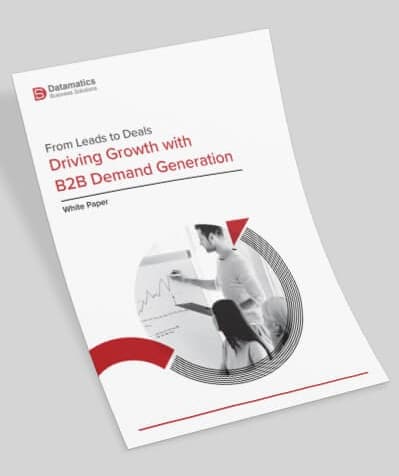In today’s hyperconnected world, capturing the attention and interest of your target audience can feel like trying to catch lightning in a bottle. That’s where demand generation campaigns come into play, transforming your marketing efforts into a force that attracts, nurtures, and ultimately leads to loyal customers.
But what exactly is demand generation? It’s more than a buzzword; it’s a strategic approach encompassing the multitude of tactics and channels used to create brand awareness, generate interest, and drive demand for your products or services.
From captivating content and personalized experiences to engaging social media campaigns, demand-generation campaigns are the backbone of modern marketing.
What are Demand Generation Campaigns?
A demand generation campaign is a strategic marketing initiative designed to generate interest, awareness, and demand for a product or service. It focuses on attracting potential customers, nurturing them through the sales funnel, and ultimately driving conversions and revenue.
Unlike direct response or lead generation campaigns that primarily aim to capture immediate sales or leads, demand generation campaigns take a broader and long-term approach. They aim to build brand awareness, educate the target audience, and establish a relationship with potential customers, even before they are ready to make a purchase.
B2B demand generation campaigns typically involve a combination of marketing channels, tactics, and content formats to engage and capture the target audience’s attention. These may include content marketing, social media marketing, email marketing, search engine optimization (SEO), paid advertising, events, webinars, and more.
Essential Building Blocks of Demand Generation Campaigns
Demand generation campaigns seek to close the revenue and sales gap. These campaigns contribute to a shorter sales cycle and buyer’s journey.
As a result, before beginning a demand gen campaign, marketers need to take into account a number of factors, such as:
Define Your Buyer's Persona
You must specify for whom you are developing B2B demand marketing campaigns. You must define the personality of your target buyer for creating customized marketing campaigns.
Utilize first- and second-party intent data to establish your buyer’s persona. You can obtain first-party intent data by observing your customers’ interactions with your on-site content. You can share your content on other websites for second-party intent data and see how it
Leverage Omnichannel Approach
Beyond developing marketing campaigns, one of the biggest challenges for marketers is getting them distributed on the appropriate marketing channel. You won’t receive any new leads from your marketing campaign if the appropriate audience does not see it.
In order to build brand awareness, you must therefore target a variety of marketing channels after understanding your buyer persona. Why, you ask?
Well, are you familiar with the 7 Cs of marketing? If not, here’s the gist of it:
This marketing idea was developed in the 1930s. According to research conducted by the film industry, a customer viewed a movie poster seven times before watching the film. This principle was created for radio and television listeners.
But given that the average person now has 8.5 social media accounts, this principle still holds in the digital age. As a result, you must target multiple channels to promote your demand generation campaign to your customers whenever they go online.
Develop Lead Magnets
Imagine you’re a clever angler, out to catch the biggest, juiciest fish in the sea of potential customers. But here’s the catch – you need the perfect bait to lure them in!
So, how do you reel in those eager buyers? It’s all about choosing the right lead magnet which is tailored to your buyer’s persona. B2B companies often use free trials or product versions to hook their clients. On the flip side, B2C retail gurus entice their customers with thrilling promotions, giveaways, or holiday sales that make shopping a true adventure.
Before casting your demand generation net, you must cook up the ideal lead magnet recipe. Once you’ve got the perfect bait, you will be reeling in happy customers left and right!
Set Metrics & KPIs
Using metrics and key performance indicators, you can better understand how your demand gen campaigns function. This will demonstrate whether or not your marketing efforts are yielding the desired ROI.
It would be best if you kept an eye on various KPIs, including traffic volume, conversion rate, engagement, monetization, and more. Other critical metrics include:
• Track the Opportunities Generated
When tracking traffic, don’t just track how many new people have arrived at your website. But keep an eye on how many of those visitors are potential leads and how many of those leads become paying clients.
• CAC
The customer acquisition cost is the money you have invested in converting a customer. This metric will help you define your marketing budget and achieve maximum ROI.
• CPL
The cost per lead is the money spent on acquiring a lead. Therefore, you can multiply CPL with the number of leads you have generated to determine your marketing campaign’s success.
• CLV
The customer lifetime value metric will show you how much you can gain from a customer. You can multiply a purchase value with purchase frequency to know how much revenue you can expect.
• Sales Cycle Timeframe
It reveals how long it takes to turn a lead into a customer. You can use this data to determine which marketing channels worked best for your company and which didn’t.
• Average Sales Value
This data will enable you to determine which client is more valuable and how much revenue you will generate from a project. You can also calculate the investment rate for each marketing channel using this metric.
6 Steps to Create an Effective Demand Generation Campaign
The demand generation tactics you build should boost brand awareness, highlight your expertise, and encourage prospects to convert to leads.
Here are the six steps you need to follow when creating a demand generation campaign
1. Set clear marketing goals-
Your strategies for generating demand will be based on the marketing objectives you hope to accomplish.
While increasing brand recognition is a big win for your demand generation team, there are other objectives you could pursue. You could also set goals to:
- Increase online engagement
- Boost your marketing-qualified leads
- Improve the quality of your leads
- Speed up prospect-to-lead conversions
- Net higher-value leads
Of course, the metrics you use to measure and the key performance indicators (KPIs) you watch will depend on the goal you are aiming for.
Although 75% of demand generation marketers plan to tie their demand generation key performance indicators more closely to revenue than before, there are a variety of different metrics you can use to assess whether you’re on track to meet your objectives.
These metrics include:
- Volume of MQLs
- Marketing-generated revenue
- ROI by channel
- Visitor to lead time
- Lead to sales time
- ROI by content type
- Lead Source
Ensure your sales department is on board with these objectives so that there is consistent messaging throughout the entire marketing mix and sales pipeline.
2. Identify the target audience
Once you are clear on your goals and the metrics by which you will evaluate your progress, you must determine who you are targeting with your campaigns.
Google Analytics or your CRM both allow you to gather first-party intent information about visitors to your website.
Through your social platforms, you can access first-party social intent data. To access and analyze third-party intent data, purchase it from a reputed B2B data provider such as Datamatics Business Solutions.
When you know your ideal potential customer, you can better tailor your demand generation framework using intent data.
3. Establish brand recognition
Once you’ve identified the target audience, create an omnichannel presence to increase brand recognition across all the main channels these potential clients use.
Consider professional websites, social media marketing, email marketing, webinars and online events, and paid advertising. You can also reach this audience offline by using radio, television, and print advertisements, live events, publicity stunts, and a physical store.
Make sure to modify each marketing initiative to reflect the preferences and behaviors of your buyer persona. After all, 93% of brands that use effective behavioral targeting strategies see increased profits.
4. Strengthen your brand as the ultimate solution
It’s not enough to show your customers that you share their values and beliefs. You must show that you can actively address their concerns. To help your target audience, create educational content highlighting their main issues and outlining solutions. Put your products and services at the heart of these solutions.
If you’re considering writing a blog post, consider developing a how-to that focuses on keywords related to the problems experienced by your ideal customers. Additionally, you can make templates and guides that function as tools for problem-solving.
Consider writing whitepapers and eBooks since according to 49% of marketers, they are the most valuable demand-generation content types. They give you space to explore a problem and provide detailed instructions on how to solve the issue with your services.
5. Convert prospects to high-quality leads
To move prospects from the demand stage to the lead stage, you need to build lead generation mechanisms that capture contact details. This enables you to direct future lead nurturing techniques at these prospects and give your sales team a way to contact them directly.
Use gated content, website forms, and free tools to capture lead data. To do this, ensure you’ve designed a lead scoring system to help prioritize the leads you connect with through your marketing activities.
Finding sources of high-quality leads is the biggest challenge facing demand generation experts. You won’t know which leads are worth following up on if you don’t score them.
6.Track and measure success
To make sure each demand generation campaign is on track to achieving your objectives, monitor its performance frequently.
This will enable you to spot any unsuccessful campaigns and save time, money, and resources. You have two options: either abandon these demand generation tactics entirely and reallocate the resources or try to tweak them to improve their performance.
Tracking your campaigns will also enable you to identify the most successful strategies for generating demand, allowing you to focus your efforts more heavily on them. You can create future campaigns based on these B2B demand generation best practices.
10 Effective Tactics for Demand Generation Campaigns
1. Produce User-generated content (UGC)
This powerful tool significantly aids in demand generation. When customers and fans create content about a brand or its products, such as reviews, testimonials, social media posts, images, and videos, it adds an authentic and relatable touch to the marketing efforts.
This content acts like a powerful magnet, pulling in more interested folks, building trust, and boosting brand awareness. So, by leveraging user-generated content wisely, you can create a buzz, foster a loyal community, and ignite the demand for your products or services.
2. Use Personalized Email Campaigns
When you send personalized emails, it’s like having one-on-one conversations with your potential customers. You’re not just another faceless sender; you become someone who gets them, understands their preferences, and cares about their needs.
And the best part? As you build this stronger connection, you nurture leads, earn trust, and move them closer to becoming loyal customers. So, if you’re looking to take your demand generation campaigns to the next level, remember that a little personalization can go a long way.
3. Content Syndication
Content syndication works wonders when it comes to demand generation campaigns. When you share your content on third-party platforms and websites, you’re tapping into their massive audiences, which might be even bigger than your own. It’s like having a celebrity endorsement for your brand! This exposure boosts your brand awareness, making more people sit up and take notice of what you offer.
The more eyes on your content, the more chances you have of attracting potential customers, and that’s what demand generation is all about – getting prospects interested, engaged, and eager to learn more.
4. Host Webinars & Events
Webinars and events are absolute game-changers when it comes to demand generation. These get-togethers help you promote your expertise to your audience directly. You get to address the very challenges your potential customers are facing. By sharing valuable insights and addressing their pain points in real-time, you’re establishing yourself as the go-to expert in your field.
Plus, the interactive nature of webinars lets you engage in live conversations, forming genuine connections with attendees. Oh, and don’t forget the icing on the cake – you can collect valuable leads during registration and follow up with them afterward to keep the momentum going.
5. Leverage the Power of Social Media
Social media plays a pivotal role in demand generation by providing businesses with a powerful platform to engage, connect, and interact with their target audience. Through various social media channels, businesses can share valuable content, promotional offers, and updates about their products or services, creating awareness and interest among potential customers.
Social media lets you have real-time conversations with your audience, answer their questions, and build trust through genuine interactions. Plus, social media ads are like laser-targeted magic spells – you can reach precisely the right people who are most likely to be interested in what you offer.
6. Boost Reach with Ads
Paid ads play a crucial role in demand generation by providing businesses with a targeted and efficient way to reach their desired audience. Businesses can promote their products or services directly to potential customers who match specific demographics, interests, or behaviors through platforms like Google Ads, Facebook Ads, LinkedIn Ads, and others.
These eye-catching ads, filled with captivating visuals and persuasive messages, are like little magnets drawing prospects to your website or landing page. And the best part? You get to track their journey and optimize your ads for better results, making each dollar you spend work harder for your business.
7. Account-Based Marketing
ABM is the future of demand generation. It plays a crucial role by driving personalized engagement and building stronger relationships with potential customers.
Instead of casting a wide net, Account Based Marketing allows businesses to create hyper-personalized content, messages, and campaigns that address individual accounts’ specific pain points and needs. By aligning marketing and sales efforts, ABM nurtures leads throughout the buyer’s journey, increasing the likelihood of conversion.
8. Compose Podcasts
Podcasts are a powerful tool in demand generation campaigns, providing a unique and engaging way to connect with the audience. With podcasts, you can reach your audience on the go – whether they’re driving, working out, or just chilling at home. It’s like chatting casually with them, sharing valuable insights, tips, and stories that resonate with their needs and interests.
Doing so builds trust, credibility, and a strong connection with your listeners. Plus, your listeners become your biggest advocates as they share your awesome podcast episodes with their friends, family, and colleagues, expanding your reach like wildfire. So, go ahead, grab that mic, and let your podcast take your demand generation efforts to a whole new level of success!
9. Optimize Landing Pages
Optimizing landing pages is a crucial element of demand generation because it significantly enhances the effectiveness of lead generation efforts. A well-optimized landing page is like a magnet that attracts and converts potential customers. By ensuring the landing page aligns with the campaign’s messaging and target audience, businesses can create a seamless and compelling user experience.
With improved conversion rates and increased traffic, optimizing landing pages becomes a driving force behind successful demand-generation campaigns, resulting in more leads and, ultimately, business growth.
10. Implement SEO Practices
SEO (Search Engine Optimization) plays a crucial role in demand generation by improving a brand’s online visibility and attracting organic traffic from search engines. When a business optimizes its website and content for relevant keywords and user intent, it ranks higher in search engine results pages (SERPs).
When you optimize your website and content with the right keywords and phrases, it’s like putting up bright neon signs that say, “Hey, we’ve got what you’re looking for!” So, when people search for products or services related to your business, ta-da! Your website pops up right at the top of those search results. It helps catch their attention at the perfect moment, and they click on your site to explore more. This increased visibility means more people are coming your way and more chances of turning those visitors into happy customers.
Conclusion
Creating high-quality content is the most crucial factor in B2B marketing’s lead and demand generation strategies. By producing quality content and captivating advertisements, you can demonstrate the worth of your offering, establish your brand’s authority, and gain the trust of potential clients.
If you want to improve your B2B marketing strategy, our demand generation solutions can help. Just write to us at: marketing@datamaticsbpm.com, and we will connect you with one of our experts and get things rolling.
 Select an element to maximize. Press ESC to cancel.
Select an element to maximize. Press ESC to cancel.
Courtney McCombs








